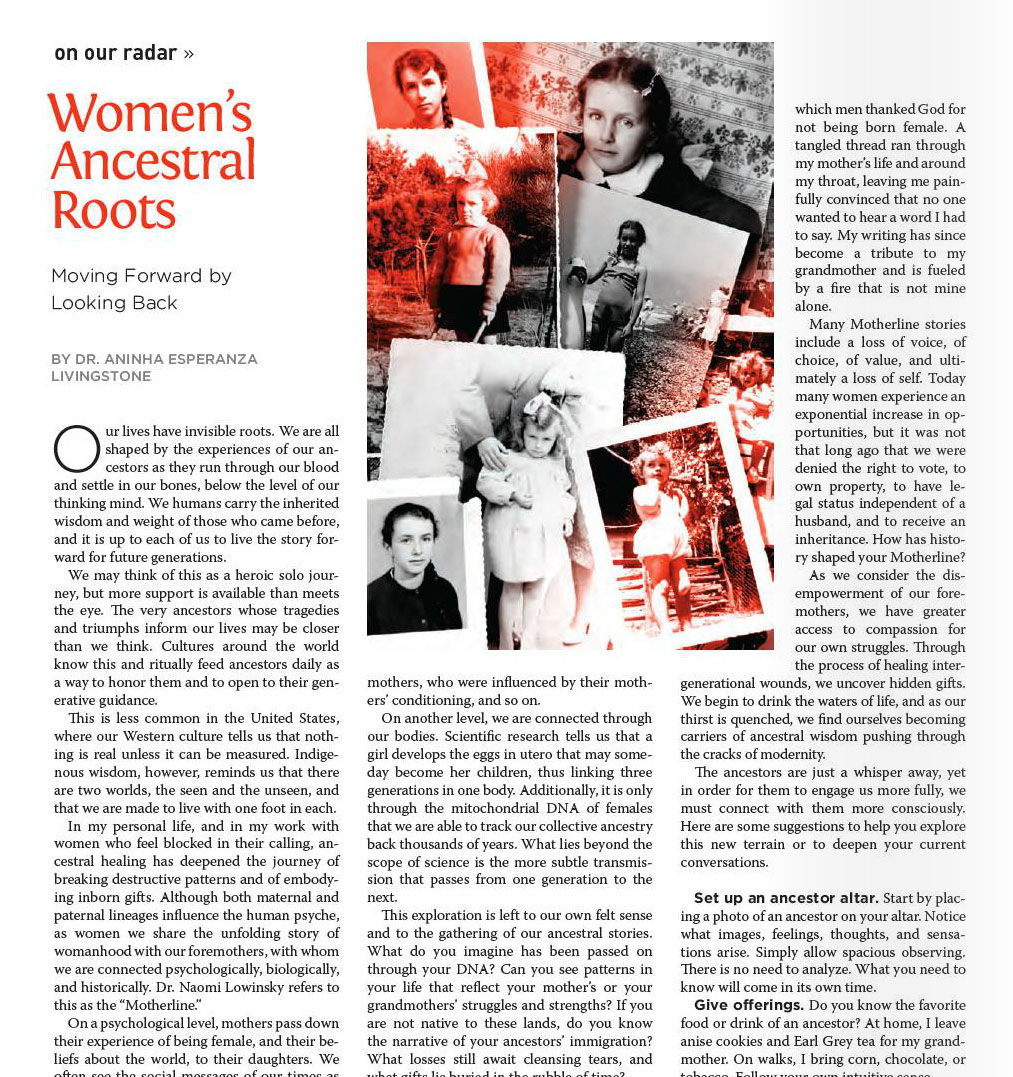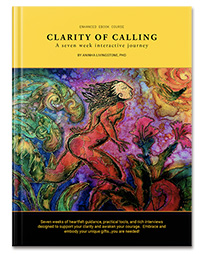 Woman’s Ancestral Roots
Woman’s Ancestral Roots
Moving Forward by Looking Back
By Aninha Esperanza Livingstone, Ph.D.
Common Ground October 2012
Our lives have invisible roots. We are all shaped by the experiences of our ancestors as they run through our blood and settle in our bones, below the level of our thinking mind. We humans carry the inherited wisdom and weight of those who came before, and it is up to each of us to live the story forward for future generations.
We may think of this as a heroic solo journey, but more support is available than meets the eye. The very ancestors whose tragedies and triumphs inform our lives may be closer than we think. Cultures around the world know this and ritually feed the ancestors daily as a way to honor them and to open to their generative guidance.
This is less common in the United States where western culture tells us that nothing is real unless it can be weighed and measured. Indigenous wisdom however reminds us that there are two worlds, the seen and unseen, and that we are made to live with one foot in each world.
In my personal life, and in my work with women who feel blocked in their calling, ancestral healing has deepened the journey of breaking destructive patterns and of embodying inborn gifts. Although both maternal and paternal lineages influence the human psyche, as women we share the unfolding story of womanhood with our foremothers with whom we are connected psychologically, biologically and historically. Dr. Naomi Lowinsky refers to this as the Motherline.
On a psychological level, mothers pass down their experience of being female, and their beliefs about the world to their daughters. We often see the social messages of our times as our primary influence but overlook the fact that our earliest attitudes were shaped by our mothers who were influenced by their mother’s conditioning, and so on.
On another level, we are connected through our bodies. Scientific research tells us that, in utero, a girl develops the eggs that may someday become her child thus linking three generations in one body. Additionally, it is only through the mitochondrial DNA of females that we are able to track our collective ancestry back thousands of years. What lies beyond the scope of science is the more subtle transmission that passes from one generation to the next.
This exploration is left to our own felt sense and to the gathering of our ancestral stories. What do you imagine has been passed on through your DNA? Can you see patterns in your life that reflect your mother’s or your grandmother’s struggles and strengths? If you are not native to these lands, do you know the narrative of your ancestor’s immigration? What losses still await cleansing tears and what gifts lie buried in the rubble of time?
My grandmother, a first generation Russian-American Jew, was born into a culture in which men thanked God for not being born female. Despite this, and the constrictive norms of her time, she traveled to Jerusalem in the 1920’s and acquired work as a journalist. Later she returned to the States to fulfill her expected role as a wife and a mother. Hoping to continue to write, she sought another journalism job only to be told, “Women belong at home raising children.”
I in turn struggled for years to claim my voice. A tangled thread ran through my mother’s life and around my throat, leaving me painfully convinced that no one wanted to hear a word I had to say. My writing has since become a tribute to my grandmother, and is fueled by a fire that is not mine alone.
Many Motherline stories include a loss of voice, of choice, of value, and ultimately a loss of self. Today many women experience an exponential increase in opportunities, but it was not that long ago that we were denied the right to vote, to own property, to have legal status independent of a husband, and to receive an inheritance. How has history shaped your Motherline?
As we consider the disempowerment of our foremothers, we have greater access to compassion for our own struggles. Through the process of healing intergenerational wounds we uncover hidden gifts awaiting reanimation. We begin to drink the waters of life, and as our thirst is quenched, we find ourselves becoming carriers of ancestral wisdom that is pushing through the cracks of modernity.
The ancestors are just a whisper away, yet in order for them to engage us more fully, we must connect with them more consciously. Here are some suggestions to help you explore this new terrain, or deepen your current conversations.
- Set up an ancestor altar: Start by placing a photo of an ancestor on your altar. Notice what images, feelings, thoughts, and sensations arise. Simply allow spacious observing. There is no need to analyze. What you need to know will come in its own time.
- Give offerings: Do you know the favorite food or drink of an ancestor? At home, I leave anise cookies and Earl Grey tea for my grandmother. On walks, I bring corn, chocolate, or tobacco. Follow your own intuitive sense.
- Write a letter: Write to an ancestor and invite their response. This requires putting your western conditioning aside, and allowing unedited writing to flow through you.
- Visit the land of your ancestors: If you are not living where your ancestor’s bones lay and you are able, you may want to travel to that part of the world. Many people have powerful experiences returning to their ancestral lands.
- Research: Whether this consists of interviewing members of your family, joining a genealogical database, or taking a saliva test, concrete information can give ground to unexplained feelings and open new pathways to intuitive explorations.
- See a professional who works with ancestral issues: There are many forms of healing available. Shamanic practitioners, psychologists who work with intergenerational trauma, and those trained in Family Constellations directly address ancestral patterns.
- Dream: Invite your ancestors into the dreamtime. Ask a specific question to help focus your conversation. Keep a dream journal by your bed, and stay with what comes even if it doesn’t make sense to your linear mind.
- Walk on the land: Set your intention to speak to an ancestor while in nature. Allow yourself to be drawn to a particular place. This spot is where the two worlds meet.
- Listen to stories of others: Whether through books, movies or oral transmission, we are enriched by hearing the mosaic of human experiences. I highly recommend Amy Tan’s The Joy Luck Club as a potent introduction to Motherline stories.
In all instances give gratitude for what you receive, and grow your relationship through trusting your experience.
Lastly, next time you think your struggles are yours alone, remember that you are a part of an ancient lineage of people who had, or continue to have their own unique traditions of connecting with the ancestors. Remember that you are accompanied, and that the freedom we experience today as women is a gift from our collective foremothers. May we be wise and courageous enough to make use of our freedom, as to leave a legacy for future generations that will make them proud to call us their ancestors.

